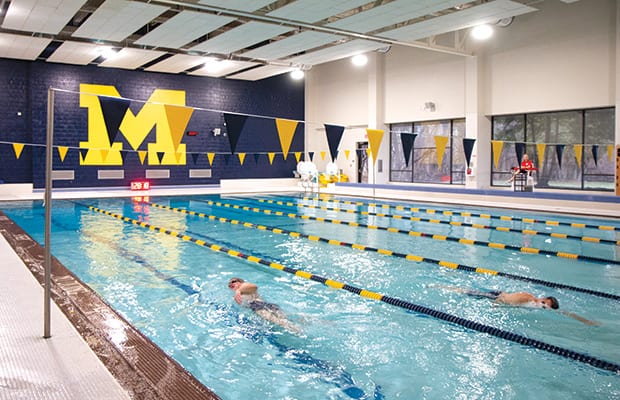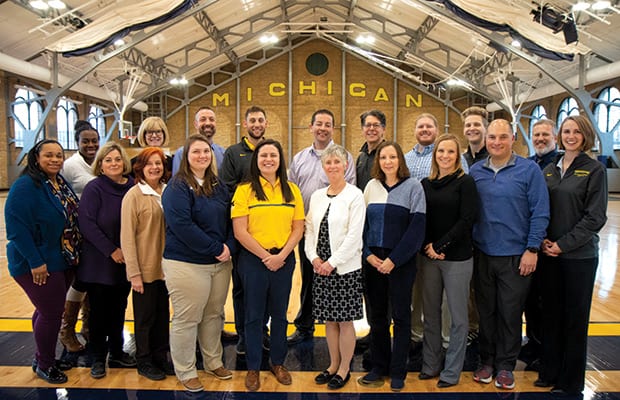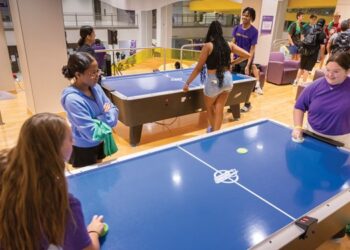Bringing together the historical and modern is quite a task. But Recreational Sports at the University of Michigan took it on.
Currently in the process of a large-scale project — a renovation on Mitchell Field, the Intramural Sports Building renovation (finished 2016), the North Campus Recreation Building renovation (finished September 2018) and the Central Campus Recreation Building (to be torn down and replaced with a new building by 2022) — students wanted a more modern feel. It began with Mitchell Field getting new lights, turf and a building. That set a bar for the rest of the renovation to reflect the brand of Michigan itself. However, the university has a rich history and alumni didn’t want to lose that. Neither did the rec staff.
“We really tried to balance the history of the building, and the history of our program, with bringing a new renovation online,” said Mike Widen, the director of Recreational Sports. “But there’s some factors of very historical significance of the building. We built in specific pieces of the building to feel very iconic and historic.”
For example, the lobby in the Intramural Sports Building retained columns that were there in 1928. Window structures stayed the same. A Michigan sign painted on the brick wall was kept. “The biggest piece for this Intramural Sports Building is the combination of history and iconic-ness with being modern in some places,” said Widen.

Inclusion has gone beyond just history. Recreational Sports has taken into consideration equipment spacing, natural lighting, and more in order to build an inclusive and comfortable space for a variety of users, student and faculty alike.
Even more than the space, it’s been the recognition that Recreational Sports is also a place for students to build community. “People find their community through us, through all our programs, through our facilities, through working for us,” said Lisa Shea, the associate director of programs and marketing.
For that reason, she said they are trying to figure out how to reach the approximately 30 percent of students who are not participating in programs and using the facilities. Plus, it means being strategic as it relates to diversity, equity and inclusion. Through surveys and assessments, Shea is continually asking how to grow their programs. “What we used to do can’t be what we will always do,” she said. “We need to get better and we always need to be trying to change and grow.”
Part of that has been expanding the intramural sports program to include community outreach, partnerships and education, which includes wellness. It also means recognizing each program is different. Each has their unique and distinct qualities, said Shea. There must be flexibility as you build and grow and market the programs.
One thing that has grown alongside the renovations and expansions at Michigan is the fitness program. Widen said before Ellen Dixon, the assistant director, came onboard, there was no fitness program. “We tasked her with creating a fitness program any campus recreation program would be proud of, that meets the needs of our students, and she took it and ran with it,” he said.

Dixon explained in order to have a successful fitness program, you need comprehensive classes. She has made it a priority that they aren’t just regurgitating pre-choreographed or pre-structured classes. Staff are sent through a mentoring program where they are given the skills to design a class that achieves a couple things: has training principle objectives or an application, and is able to be taught to a wide-variety of levels.
While each program application is different and always evolving, Dixon said instructors primarily have to go through an industry certification or workshop to begin. The different workshops focus on specific teaching skills or principles. If they do well in the tryout however, they can bypass the workshops and get matched immediately with a veteran instructor in one of his or her classes. They are shown the ropes and slowly given more responsibility in terms of teaching class. Plus, they get immediate constructive feedback.
“I think in terms of employment and staff development, that is something we do really well. We are very student-focused, and we want to develop the students we hire into high-quality fitness professionals,” said Dixon. “We really try our best to create an inclusive environment with how our programs are structured, but then also how we work with our staff, what they do and what their skills are and what their messaging is to make those programs inclusive.”
This sort of training — investing the time into students — is also happening with the professional staff. Widen said when Dixon came on board, he didn’t want to get in her way of building the fitness program. She was the expert and he wanted to capitalize on her knowledge and background.
“We’ve really hired great people, and those people are good examples of how do you let people go with their ideas and building their programs,” said Widen. “I believe leadership starts and ends with relationships with the staff on your team, the supervisors you work for, and with other colleagues both inside and outside of campus. I also think that as a leader, I provide my team opportunities to try their own ideas for their particular areas of responsibilities. I want to allow people to be creative and have opportunities to make decisions that can grow our work.”
Shea said she also has to give her team space to grow. “My team is phenomenal,” she said. “When I say they are experts in their area, they are experts in their area. They do the research; they do more than I can even ask. Where I come in and what I believe as their supervisor is opening doors, providing resources, or helping them get the resources they need to keep our programs on the cutting edge.”

Another example is that of the Adventure Leadership Program. About three years ago, there was an opportunity to merge Outdoor Adventures and the Challenge Program into one. Shea said it changed the direction of the program as well as brought the team together. They were able to capitalize on the strengths of both programs, as well as bring trips and rentals under the same umbrella. Plus, it now offers students in those areas jobs year-round, versus just having a job on the high ropes course when the weather permitted. Now, during the winter they work the rental desk.
And the Adventure Leadership program isn’t stagnant. It’s growing, changing and shifting. Shea said there is talk about climbing and bouldering experiences to be added to the new Central Campus Recreation Building. But, until that happens it will continue to service groups in team building and the high ropes course, from both on campus and off.
“We’ve grown that program to be really solid in terms of our area and the community we sit in,” said Widen.
Ultimately, it comes down to providing opportunity: for the professional staff, for programs to grow and for history to meet the modern age. But, all of that comes after the students. Widen said one of the most important lessons he’s learned is to try and make decisions based on what is best for the students. If you do that, you can’t go wrong, whether it’s about something old or something new.
“At times, there are decisions to be made that could be easier for staff, or save the most money, but at the end of the day, we need to provide the best experience we can for the students we serve,” said Widen. “My experience in campus recreation as an undergraduate led me to find my passion. As campus recreation professionals, we need to provide opportunities so the students we serve today can find their passions.”










